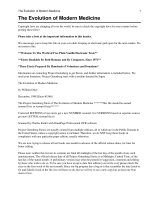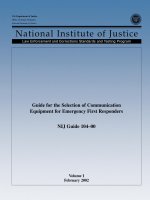THE PHYSICS OF MODERN BRACHYTHERAPY FOR ONCOLOGY docx
Bạn đang xem bản rút gọn của tài liệu. Xem và tải ngay bản đầy đủ của tài liệu tại đây (17.01 MB, 670 trang )
Series in
Medical Physics and Biomedical Engineering
D Baltas
Klinikum Offenbach, Germany
and
University of Athens, Greece
New York London
Taylor & Francis is an imprint of the
Taylor & Francis Group, an informa business
The Physics of
Modern Brachytherapy
for Oncology
N Zamboglou
Klinikum Offenbach, Germany
L Sakelliou
University of Athens, Greece
CRC Press
Taylor & Francis Group
6000 Broken Sound Parkway NW, Suite 300
Boca Raton, FL 33487‑2742
© 2007 by Taylor & Francis Group, LLC
CRC Press is an imprint of Taylor & Francis Group, an Informa business
No claim to original U.S. Government works
Printed in the United States of America on acid‑free paper
10 9 8 7 6 5 4 3 2 1
International Standard Book Number‑10: 0‑7503‑0708‑0 (Hardcover)
International Standard Book Number‑13: 978‑0‑7503‑0708‑6 (Hardcover)
This book contains information obtained from authentic and highly regarded sources. Reprinted
material is quoted with permission, and sources are indicated. A wide variety of references are
listed. Reasonable efforts have been made to publish reliable data and information, but the author
and the publisher cannot assume responsibility for the validity of all materials or for the conse‑
quences of their use.
No part of this book may be reprinted, reproduced, transmitted, or utilized in any form by any
electronic, mechanical, or other means, now known or hereafter invented, including photocopying,
microfilming, and recording, or in any information storage or retrieval system, without written
permission from the publishers.
For permission to photocopy or use material electronically from this work, please access www.
copyright.com ( or contact the Copyright Clearance Center, Inc. (CCC)
222 Rosewood Drive, Danvers, MA 01923, 978‑750‑8400. CCC is a not‑for‑profit organization that
provides licenses and registration for a variety of users. For organizations that have been granted a
photocopy license by the CCC, a separate system of payment has been arranged.
Trademark Notice: Product or corporate names may be trademarks or registered trademarks, and
are used only for identification and explanation without intent to infringe.
Library of Congress Cataloging‑in‑Publication Data
Baltas, Dimos.
The physics of modern brachytherapy for oncology / Dimos Baltas, Loukas
Sakelliou, and Nikolaos Zamboglou.
p. cm. ‑‑ (Series in medical physics and biomedical engineering)
Includes bibliographical references and index.
ISBN‑13: 978‑0‑7503‑0708‑6 (alk. paper)
ISBN‑10: 0‑7503‑0708‑0 (alk. paper)
1. Radioisotope brachytherapy. I. Zamboglou, N. (Nickolaos) II. Sakelliou,
Loukas. III. Title. IV. Series.
RC271.R27B35 2007
615.8’424‑‑dc22 2006005610
Visit the Taylor & Francis Web site at
and the CRC Press Web site at
Imperturbable wisdom is wortheverything. To awiseman,the
whole earth is open; for the native land of agood soul is the whole
earth. Medicine healsdiseases of the body; wisdomfrees the soul
from passions. Neither skill nor wisdom is attainable unless one
learns. Beautiful objects are wroughtbystudy through effort, but
ugly things are reaped automaticallywithout toil.
On Learning, Democritus (460–370 B.C.)
Preface
This Physics of Modern Brachytherapy for Oncology is the most comprehensive
brachytherapy textbook for physicists that has so far been written and
intentionally includes chaptersonbasic physics that are neces sary for an
understanding of modern brachytherapy.The book thereforestands alone
as a total reference book,with readers not havingtoconsultother texts to
obtain information on the basics, which are presented in Chapter 2through
Chapter 4and are set out in alogical fashion starting with quantitiesand
units, followed by basic atomic and nuclear physics.
It was only after the development of the atomic bomb in the Manhattan
project in the late 1940s that the peaceful uses of ionizing radiation(other
than radiumand radon) wereharnessed in medicine.This led to the
introduction of
60
cobalt and
137
cesium in the late 1950s andthese
radionuclides replaced radiumfor the manufacture of tubes and needles
and
198
gold seeds replaced the radon seeds.However, there was still a
problem with the tubes andneedles because asufficiently high specific
activity could not be achieved and thin malleable wire sources were
impossible to make using
60
Co and
137
Cs. This was eventually overcome in
the ear ly 1960s by initially using
182
tantalum wire and later
192
iridiumwire,
with the latter beingthe standard brachytherapy source today not only for
use with the Paris system but also in the form of miniature sources for use
with high dose rate (HDR) afterloading machines. With radium and
137
Cs
only,low dose rate (LDR) brachytherapy could be performed, again because
of specificactivity limitations.
60
Co was first used for HDRafterloaders but
was tooexpensive because of the need for regular source replacements and
for extended radiation protection infrastructure.
192
Ir was acheaperoption.
Work continues on possibilitiesfor the use of new radionuclides suchas
241
americium,
169
ytterbiumand
145
samarium,but currentlythe three
mainstayradionuclides are
192
Ir,
125
iodine and
103
palladium. Thisisreflected
in the contents of Chapter5and Chapter6.
Dosimetry is an essential partofbrachytherapy physicsand has been from
the earliest days when the first measurements were madebyMarie Curie
usingthe piezo electrometer designed by Pierre Curie and his brother
Jacques.However, international agreement on radiumdosimetryunits took
manyyears and, for example, the roentgen unit of exposure was not
recommended by the ICRU as aunit of measurement for both x-rays and
radiumgamma rays until 1937. Previously therewas adifferentiation
betweenx-ray roentgens and gamma ray roen tgens. Also, prior to 1937,
more than 50 proposals for radiation units had been made, depending not
only on the ionization effect, but also on, for example, silver bromide
photographic film blackening, fluorescence and skin erythema. The latter
formed the basis of the radiumdosage system developed by the phys icist
Edith Quimby at Memorial Hospital, New York.
The most popular unitused was the milligram-hour,which was merely
the product of the milligrams of radiumand the durationofthe treatment.
For radon, the analogous unitwas millicurie-destroyed since radon had a
half-lifeofonlysome3.5 days. However,the best experimental results were
made using ionization chambers, particularly those developed in the late
1920s by the physicist RolfSievert of the Radiumhemmet in Stockholm,
who was also responsible for the Sievert integral. Sourcecalibration and
dosimetryprotocols are considered in Chapter 7and Chapter 8. Monte Carlo
aided and experimentaldosimetry,including gel dosimetry,which has only
been available in the last decade,are the topics in Chapter 9and Chapter10.
Dimos Baltas
NikolaosZamboglou
LoukasSakelliou
Acknowledgments
This book could not be compl eted without the contri butions,simulations,
discussions and efforts of several co lleagues, collaborators and friends.
There are alot of peoplewho playedspecificroles in the book itself. We
cannotmention all but would particularly like to single out, for special
thanks and gratitude, the following:
R.F.Mould, for creating with us the idea for this book and providing the
excellent review on the early history of brachytherapy physics presented in
Chapter 1.
A.B. Lahanas, for contributingthe comprehensive review of elementary
particlesand the StandardModel in Chapter 3.
J. Heijn, for enabling adetailed insigh tinto the production methods and
processes of the most importantradionuclides by providing the material in
Chapter 6.
P. Papagiannis, for his essential contribution to the TLD and gel dosimetry
sections in Chapter10aswell as to the Monte Carlo sections in Chapter 9of
the book.Weare very grateful for his comments, clarifications, discussions,
collaboration and friendship.
E. Pantelis, for the production of the original data and Monte Carlo
simulation results that facilitatedthe discussioninChapter 4and Chapter9.
G. Anagnostopoulos, for his gracioushelp in providing Monte Carlo
simulation results for the different phantom materials and his contribution
to the TLD section in the experimentaldosimetr y, Chapter10.
Authors
Dr.Dimos Baltas is the director of the Department of Medical Physics and
Engineering of the StateHospital in Offenbach, Germany.Since 1996, he
has been associate adjunct research professor for Medical Physicsand
Engineering of the Institute of Communication and Computer Systems
(ICCS), at the Department of Electrical and Computer Engineering, National
Technical University of Athens and since 2005 he has been an honorary
scientific associate of the Nuclear Physics andElementary Particles Section,
at the Physics Department, UniversityofAthens, Greece. He received his
PhD in medical physics in 1989 at the UniversityofHeidelberg, Germany
and did research in applied radiationbiology,modeling and radiobiology-
based planning. He has pursued research in the field of dosimetry,quality
assurance and technology in brachytherapy since the late1980s.His
contributionstobrachytherapy physics and technology include experimen-
tal dosimetryofhigh activity sources, development and establishment of
dosimetryprotocols, advanced quality assurance procedures and systems,
experimentaland Monte Carlo–based dosimetry of new high and low
activity sources, development of new algorithms for dose calculation and for
imaging-based treatment planning in brachytherapy as well as development
of new radionuclides for brachytherapy.Hehas written more than 80
refereed publications and ten chapter contributions in published books. Ten
diploma thesesand 12 PhD dissertations have been completed underhis
supervision. He is member of the German AssociationofMedical Physics
(DGMP), of the German Association for Radiation Oncology (DEGRO),of
the European Socie ty for Therapeutic Radiology and Oncology (ESTRO), of
the American Association of Physicists in Medicine (AAPM)and of the
Greek Association of Physicists in Medicine (EFIE).Since 2000, he has been
the Chairman of the Task Group on Afterloading Dosimetry of the German
Association of Medical Physics (DGMP).Since 2004, he has been amember
of the Medical Physics Experts Group for Reference Dosimetry Data of
Brachytherapy Sources (BRAPHYQS group of ESTRO) and since 2005, a
memberofthe Scientific Advisory Board of the Journal Strahlentherapie und
Onkologie, JournalofRadiation Oncology Biology Physics.
Dr.LoukasSakelliou is associate professor in the Nuclear Physics and
Elementary Particles Section, at the PhysicsDepartment, University of
Athens, Greece. He received his PhD in physics in 1982, then did research in
experimentalparticle physics and participated in anumber of experiments
at CERN (including CPLEAR, Energy Amplifier and TARC). He pursued
research in the field of medical physics in the early 1990s. His contribution
to the field of brachytherapy includes, mainly although not exclusively,
the Monte Carlo modeling of medical radiation sources for the generation
of dosimetrydata for use in clinical practice.Hehas writtenover 100
refereedpublicationsand 10 PhDdissertations have been completed
under his supervision. Dr.Sakelliou is presently the head of the Dosimetry
Laboratoryofthe Institute for Accelerating Systems and Applications (IASA,
Athens, Greece) and amemberofthe founding board of an MSc course in
medical physics. He teaches atomic and nuclear physics, modern physics
and medical physics and his currentresearch interests include Monte
Carlo simulation and analytical dosimetry methods with afocus on the
amendment of radiation therapy treatment planning methods, experimental
brachytherapy dosimetryusingpolymergels and treatment verification in
contemporary radiationtherapy techniques.
Dr.Nikolaos Zamboglou is the chairman of the Radiation Oncology Clinic
of the State Hospital in Offenbach, Germany.Since 1990, he has been a
member of the Faculty of Medicine in Radiation Oncology of the University
of Du
¨
sseldorf Germany,and since 1993 adjunct research professor at the
InstituteofCommunication and Computer Systems (ICCS)ofthe National
Technical University of Athens. He received his PhD in physics in 1977 at
the Faculty of Science of the University of Du
¨
sseldorf and in medicine, MD,
in 1987 at the Faculty of Medicine,University of Essen, Germany.Hedid
research in biological dosimetry, radiation protection, radiation biology
focusedonthe radio-sensitivity of cells and clinical research in simultaneous
radio-chemotherapy and brachytherapy.His current research area is the
clinical implementation of advanced technologiesand imaging-based
techniques in radiation oncology especially focusedonhigh dose rate
brachytherapy,inwhich he has been active since the late 1980s. He has
writtenmorethan 110refereed publications and more than 30 chapter
contributions in published books. Twenty-five PhD and MD dissertations
have been completed under his supervision. He is amemberofthe German
AssociationofMedical Physics (DGMP),ofthe German Association for
Radiation Oncology (DEGRO), of the European Society for Therapeutic
Radiology and Oncology (ESTRO), and of the Hellenic Society forRadiation
Oncology (HSRO). Since 2000, he has been the Chairman of the Task Group
on 3D Treatment Planning in Brachytherapy of the German Association
for Radiation Oncology (DEGRO). Since 2001hehas been amemberofthe
Steering Committee of the German Association for Radiation Oncology
(DEGRO), where for the period of 2003 to 2005 he was President. Since 1996,
he has been amember of the Scientific Advisory Board of the Journal
Strahlentherapie und Onkologie,Journal of Radiation Oncology Biology Physics.
Contents
Chapter 1The Early History of Brachytherapy Physics 1
1.1 Introduction 1
1.2 Discoveries 2
1.3 Ionizationand X-Rays 2
1.4 a , b , g ,and Half-Life 3
1.5 Nuclear Transformation 4
1.6 Rutherford–BohrAtom 5
1.7 The Start of Brachytherapy 7
1.8 Dose Rates 8
1.9 Dosimetry Systems 8
1.10 Marie Curie 10
References 11
Chapter 2Radiation Quantities and Units 15
2.1 Introduction 15
2.2 Ionizationand Excitation 16
2.2.1 Ionizing Radiation 18
2.2.2 Types and Sources of Ionizing Radiation 19
2.2.2.1 Electromagnetic Radiation 19
2.2.2.2 g -Rays 19
2.2.2.3 X-Rays 19
2.2.2.4 Particulate Radiation 20
2.2.2.5 Electrons 20
2.2.2.6 Neutrons 20
2.2.2.7 Heavy Charged Particles 20
2.3 Radiometry 20
2.3.1 RadiantEnergy 20
2.3.2 Flux and Energy Flux 21
2.3.3 Fluenceand Energy Fluence 22
2.3.4 FluenceRate and Energy Fluence Rate 22
2.3.5 ParticleRadiance and Energy Radiance 22
2.4 Interaction Coefficients 23
2.4.1 Total and Differential Cross-Section 24
2.4.2 Linear and Mass Attenuation Coefficient 24
2.4.3 Atomic and Electronic Attenuation Coefficient 26
2.4.4 Mass Energy TransferCoefficient 26
2.4.5 Mass Energy Absorption Coefficient 27
2.4.6 Linear and Mass StoppingPower 28
2.4.7 Linear Energy Transfer (LET) 29
2.4.8 Mean Energy ExpendedinaGas per
Ion Pair Formed 29
2.5 Dosimetry 30
2.5.1 Energy Conversion 30
2.5.1.1 Kerma 31
2.5.1.2 Kerma Rate 32
2.5.1.3 Exposure 32
2.5.1.4 Exposure Rate 33
2.5.1.5 Cema 33
2.5.1.6 Cema Rate 34
2.5.2 DepositionofEnergy 34
2.5.2.1 Energy Deposit 35
2.5.2.2 Energy Imparted 35
2.5.2.3 AbsorbedDose 36
2.5.2.4 AbsorbedDose Rate 36
2.6 Radioactivity 36
2.6.1 Decay Constant 37
2.6.2 Activity 37
2.6.2.1 Specific Activit y 38
2.6.3 Air Kerma-Rate Constant 38
References 40
Chapter 3Atoms, Nuclei, Elementary Particles, and Radiations 43
3.1 Atoms 43
3.1.1 The Bohr Hydrogen Atom Model 44
3.1.2 The QuantumMechanical Atomic Model 46
3.1.3 Multielectron Atomsand Pauli’s Exclusion Principle 51
3.1.4 Characteristic X-Rays. Fluorescence Radiation 52
3.2 Atomic Nucleus 53
3.2.1 Chart of the Nuclides 54
3.2.2 Atomic and Nuclear Massesand Binding Energies 57
3.2.3 The Semiempirical Mass Formula 59
3.3 Nuclear Transformation Processes 62
3.3.1 Radioactive Decay 63
3.3.2 Radioactive Growth and Decay 64
3.3.3 Nuclear Reactions 67
3.4 Modes of Decay 70
3.4.1 Alpha Decay 71
3.4.2 Beta Decay 72
3.4.2.1
b
2
Decay 74
3.4.2.2
b
þ
Decay 75
3.4.2.3 Electron Capture 77
3.4.3 Gamma Decay and InternalConversion 79
3.5 ElementaryParticlesand the StandardModel 80
References 85
Chapter 4Interaction Properties of Photons and Electrons 87
4.1 Introduction 87
4.2 Photon Interaction Processes 90
4.2.1 PhotoelectricEffect (Photoabsorption) 94
4.2.2 Coherent (Rayleigh)Scat tering 118
4.2.3 Incoherent (Compton) Scattering 120
4.3 Mass Attenuation Coefficient 126
4.4 Mass Energy Absorption Coefficients 128
4.5 Electron Interaction Processes 132
4.6 Analytical Dose Rate Calculations 135
References 138
Chapter 5Brachytherapy Radionuclides and Their Properties 141
5.1 Introduction 141
5.1.1
226
Radon SourceProduction 141
5.1.2 Artificially Produced Radion uclides 142
5.1.3 Properties 143
5.1.3.1 Radioactive Decay Scheme 143
5.1.3.2 Half-Life T
1/2
143
5.1.3.3 Specific Activity 143
5.1.3.4 Energy 143
5.1.3.5 Density and Atomic Number 145
5.2 Notation 147
5.3
60
Cobalt 148
5.3.1 Teletherapy 149
5.3.2 Brachytherapy 149
5.4
137
Cesium 152
5.5
198
Gold 154
5.6
192
Iridium 157
5.7
125
Iodine 164
5.8
103
Palladium 167
5.9
169
Ytterbium 169
5.10
170
Thullium 178
References 183
Chapter 6Production and Construction of Sealed Sources 185
6.1 Introduction 185
6.2
192
Iridium Sources 189
6.2.1 HDR Remote Afterloading Machine Sources 189
6.2.2 LDR Seed and Hairpi nSources 193
6.3
125
Iodine LDR Seeds 193
6.4
103
PalladiumLDR See ds 195
6.5
169
YtterbiumSources 196
6.6
60
Cobalt HDR Sources 196
6.7
137
Cesium LDR Sources 197
6.8
198
Gold LDR Seeds 197
6.9
170
Thulium HighActivity Seeds 197
6.10
131
Cesium LDR Seeds 198
6.11Enrichment Methods 199
6.11.1 Ultracentrifuge 199
6.11.2 Laser Enrichment 200
6.11.3 The Calutron 201
6.12 b -Ray Emitting Microparticles and Nanoparticles 202
Acknowledgments 202
Reference 203
Chapter 7Source Specification and Source Calibration 205
7.1 Source Specification 205
7.1.1 Introduction 205
7.1.1.1 Mass of Radium 205
7.1.1.2 Activity 205
7.1.1.3 EquivalentMass of Radium 206
7.1.1.4 Emission Properties 206
7.1.1.5 Reference Exposure Rate 207
7.1.2 Reference Air Kerma Rate and Air Kerma Strength 207
7.1.3 Apparent Activity 209
7.2 Source Calibration 212
7.2.1 CalibrationUsing an In-Air Set-Up 213
7.2.1.1 Geometrical Conditions 214
7.2.1.2 Ionization Chamber 218
7.2.1.3 Formalism 222
7.2.1.4 Summary 246
7.2.2 CalibrationUsing aWell-Type IonizationChamber 248
7.2.2.1 Formalism 248
7.2.2.2 Geometrical Conditions 256
7.2.2.3 Calibration of
192
Ir LDR Wires 259
7.2.2.4 Stability of Well-Type ChamberResponse 261
7.2.2.5 Summary 263
7.2.3 CalibrationUsing Solid Phantoms 265
7.2.3.1 Geometrical Conditions 266
7.2.3.2 Ionization Chambers 268
7.2.3.3 Formalism 269
7.2.3.4 Summary 280
7.2.4 Comparison of Methods 281
References 285
Chapter 8Source Dosimetry 291
8.1 Introduction 291
8.2 Coordinate Systems and Geometry Definition 291
8.3 Models of Dose Rate and Dose Calculation 294
8.3.1 Ideal Point Sources 294
8.3.2 Real Sources 298
8.3.2.1 Finite Source Core Dimensions 298
8.3.2.2 SelfAbsorption and Attenuation 300
8.3.3 The TG-43 Dosimetry Formalism 301
8.3.3.1 The Basic Concept 301
8.3.3.2 Reference Medium 302
8.3.3.3 Reference of Data 302
8.3.3.4 Source Geometry 302
8.3.3.5 Reference Point of DoseCalculations ( r
0
,
u
0
) 302
8.3.3.6 Formalism 302
8.3.3.7 The 2D TG-43 Formulation 309
8.3.3.8 The 1D TG-43 Approximation 315
8.3.4 The RevisedTG-43 Dosi metry Formalism 317
8.3.4.1 The Transverse-Plane 318
8.3.4.2 Seedand Effective Length L
eff
318
8.3.4.3 The Basic Consistency Principle 319
8.3.4.4 The Geometry Function G
X
ð r ;
u
Þ 319
8.3.4.5 The Radial Dose Function g
X
( r ) 321
8.3.4.6 The Air Kerma Strength S
K
322
8.3.4.7 The Revised TG-43 2D Dosimetry Formalism 323
8.3.4.8 The Revised TG-43 1D Dosimetry
Approximation .323
8.3.4.9 Implementation Recommendations 324
8.4 TG-43 Data for Sources 328
8.4.1 Sources Used in HDR Brachytherapy 329
8.4.1.1
192
Ir Sources 329
8.4.1.2
60
Co Sources 349
8.4.1.3
169
Yb Sources 357
8.4.2 Sources Used in PDR Brachyth erapy 358
8.4.2.1 Sources for the MicroSelectron PDR
Afterloader Syste m 359
8.4.2.2 Sources for the GammaMed PDR Afterloader
Systems 12i and Plus 364
8.4.3 Sources Used in LDR Brachytherapy 366
8.4.3.1
137
Cs Sources 367
8.4.3.2
125
ISources 374
8.4.3.3
103
Pd Sources 375
8.5 Dose Rate Look-Up Tables 382
8.6 Dose from Dose Rate 384
References 386
Chapter 9Monte Carlo–Based Source Dosimetry 393
9.1 Introduction 393
9.2 Monte Carlo Photon Transport Simulations 394
9.2.1 Random Numbers and Sampling 394
9.2.2 Simulating Primary Radiation 395
9.2.3 Choosing Interaction Type 399
9.2.4 Simulating Interactions 400
9.3 Monte Carlo–Based Dosimetry of Monoenergetic
Photon Point Sources 405
9.4 Monte Carlo–Based Dosimetry of
103
Pd,
125
I,
169
Yb,
and
192
Ir Point Sources 407
9.5 Monte Carlo–Based Dosimetry of Commercially
Available
192
Ir Source Designs 413
9.6 Monte Carlo–Based Dosimetry of
125
Iand
103
Pd
LDR Seeds 421
References 424
Chapter 10 Experimental Dosimetry 429
10.1 Introduction 429
10.2 PhantomMaterial 437
10.3 Ionization Dosimetry 445
10.3.1 Measurement of Dose or Dose Rate 447
10.3.1.1 Calibration Factors N
K
, N
W
,and N
X
450
10.3.1.2 Chamber Finite Size Effect Correction
Factor k
V
450
10.3.1.3 Phantom Dimensions 450
10.3.1.4 Room Scatter Effects 451
10.3.1.5 OtherEffects 451
10.3.1.6 Calculating Dose Rate from Dose 451
10.4 TLD Dosimetry 451
10.4.1 Introduction 451
10.4.2 Summary of the Simplified Theory of TL 452
10.4.3 TL Brachytherapy Dosimetry 453
10.4.4 Annealing of TL Dosimeters 455
10.4.5 ReadoutofTLDosimeters 457
10.4.6 Calibration of TL Dosimeters 459
10.4.7 PracticalConsiderations and Experimental
Correction Factors 462
10.4.8 Uncertainty Estimation 470
10.5 Polymer Gel Dosimetry in Brachytherapy 471
10.5.1 Introduction 471
10.5.2 The Basics of Polymer GelDosimetry and
Gel Formulations 472
10.5.3 Magnetic Resonance ImaginginPolymer Gel
Dosimetry 476
10.5.4 Calibration of Polymer Gel Dose Response 480
10.5.5 PolymerGel Dosimetry Applied in Brachytherapy 486
10.5.5.1 Single Source 486
10.5.5.2 Treatment Plan Dos eVerification 492
References 495
Appendix 1Data Table of the Selected Nuclides 507
References 522
Appendix2 Unit Conversion Factorsand PhysicalConstants 523
References 526
Appendix3 TG-43 Tables for Brachytherapy Sources 529
A.3.1 MicroSelectron HDR Classic
192
Ir Source 531
A.3.2 MicroSelectron HDR New
192
Ir Source 533
A.3.3 VariSourceHDR Old
192
Ir Source 535
A.3.4 VariSourceHDR New
192
Ir Source 537
A.3.5 Buchler HDR
192
Ir Source 539
A.3.6 GammaMed HDR
192
Ir Source Models 12i andPlus 542
A.3.7 BEBIGMultiSource HDR
192
Ir Source Model GI192M11 547
A.3.8 Ralstron HDR
60
Co SourceModels Type 1, 2, and 3 550
A.3.9 BEBIGMultiSource HDR
60
Co Source ModelGK60M21 558
A.3.10ImplantSciences HDR
169
Yb Source Model HDR4140 561
A.3.11MicroSelectron PDR Old and New
192
Ir Source Designs 563
A.3.12GammaMedPDR
192
Ir Source Models 12i and Plus 566
A.3.13LDR
137
Cs SourceModels 571
A.3.14LDR
125
ISource Models 582
A.3.15LDR
103
Pd Source Models 586
References 588
Appendix4 Dose Rate Tables for Brachytherapy Sources 591
A.4.1 MicroSelectron HDR Classic
192
Ir Source 593
A.4.2 MicroSelectron HDR New
192
Ir Source 595
A.4.3 VariSource HDR Old
192
Ir Source 597
A.4.4 VariSource HDR New
192
Ir Source 599
A.4.5 Buchler HDR
192
Ir Source 601
A.4.6 GammaMed HDR
192
Ir Source Models 12i and Plus 603
A.4.7 BEBIGMultiSource HDR
192
Ir Source Model GI192M11 607
A.4.8 Ralstron HDR
60
Co SourceModels Type 1, 2, and 3 609
A.4.9 BEBIGMultiSource HDR
60
Co Source Model GK60M21 615
A.4.10MicroSelectron PDR Old and New
192
Ir Source Designs 617
A.4.11GammaMed PDR
192
Ir SourceModels 12i and Plus 621
A.4.12LDR
137
Cs Source Models 625
References 634
Index 637
1
The Early History of Brachytherapy Physics
1.1Introduction
The textbook written by Paul Davies in 1989
1
entitled, The New Physics,
commenced with the following opinion.
Many elderly scientists look back nostalgically at the first30years
of the 20th century,and refer to it as the golden age of physics.
Historians, however,may come to regard those years as the
dawning of the New Physics. The events which the quantum and
relativity theories set in train are only now impinging on science,
and manyphysicists believe that the goldenage was onlythe
beginning of the revolution.
This is particularly true for the start of the 21st century in the field of
modern brachytherapy whichisatreatment modalitywithin the framework
of oncology,and which encompassesthe entire spectrum of cancer
diagnosis and treatment. Complexsoftware programs are now an integral
part of the brachytherapy process and links to CT,MR, and ultrasound
imaging are now the norm ratherthan the unusual. Indeed,modern
brachytherapy has changedout of all recognition to what it was even 50
years ago. Then, brachytherapy had been more or less standardized for a
couple of decades with geometric-baseddosimetry systems, no radium
and radon replacement radionuclides suchas
60
Co and
137
Cs, no digital
computers, with all body tissues assumedtobeofunitdensity,noroutine
consideration of radiobiology,noremote afterloading and very little manual
afterloading and with manyinstitutions relyingonthe milligram–hour unit
for radium and the millicurie destroyed per square centimeter for radon,
even though the roentgen unithad been introducedfor both x-rays and
gamma rays in 1937.
2,3
The golden age of brachytherapy is thereforestill ahead of us and
certainly not behind us in the 20th century, when in the 1940s and 1950s it
might even be said to have stagnated for aperiod of time.Ifthere was
1
anything golden about suchatime it was amisnomer in that dosimetryand
planning had been unchanged for so long that physicists did not have to
think very hard in terms of calculations. For example, it was very easy to
plan aradium implantdelivering 1000 Rper day at 0.5 or 1.0 cm distance;
and for intracavitarygynecological insertions there was often onlyachoice
of vaginal ovoids whichwere eitherlarge, medium,orsmall and of an
intrauterine tube which was standardized as short, medium,orlong.
Simulators had not been developed and athree-dimensional distribution
using an analog-computingdevice could take aphysicist 24 htoperform,
which in practice meant that very few hospitals bothered to consider this.
Theplanning = verificationimages were mainly only lateral andAP
orthogonal radiographs, obtained to determine whether or not the radium
sources were correctly positioned.
However,history should not be ignored because one can always learn
from the past and it is interesting to recordthat by the year 1910 the principal
of afterloading had been enunciated both in Europe
4
and the United States.
5
Also, manyradiobiologicalexperiments had been performed: one of the
earliest self-exposure studies being by Pierre Curie workingwith Henri
Becquerel in 1901.
6
Thisfirst chapter in The Physics of Modern Brachytherapy
for Oncology therefore looks back to someofthe physics discoveries,
concepts, and ideas that have formed the foundations of today’s modern
brachytherapy practice.
1.2Discoveries
The three seminal discoveries that occurred at the end of the 19th century
were, of course,those of x-rays by Ro
¨
ntgen,
7,8
radioactivity by Becquerel,
9
and radium by the Curies.
10
Also, betweenthe discoveries of radioactivity
and radium, thereoccurred the discoveries of thorium by Schmidt
11
and of
poloniumbythe Curies.
12
These set the scene for the work of Rutherfordand
for leading to the nuclear transformation theory of Rutherford and Soddy in
1902 and later the Rutherford–Bohr atom.
1.3Ionizationand X-Rays
Ernest Rutherford’s research career began in 1893 and his first paper was
on the magnetization of ironbyhigh-frequency discharges.
13
His work on
magnetism continued in Cambridge
14
until 1896 but then at Thomson’s
suggestionheabandoned this work to concentrate on research usingthe
newly discovered x-rays. In particular,this was to study the power of x-rays
to render air conductive by the process of ionization.
The Physics of Modern Brachytherapy for Oncology2
The first paper on ionization was published in 1896
15
and this was
followed by one
16
in which Rutherford introduced the conceptofthe
coefficientofabsorption and demonstratedthat the leak of agas (i.e., the
ionization current) is proportional to the intensity of radiationatany point in
time. His third paper
17
on ionization contained at the end of the paperhis
first reference to the use of “the radiationgiven out by uraniumand its salts.”
However, as emphasizedbyCohen,
13
Rutherford at this time considered
radiationtobeatool for investigating, and not the other way around.
1.4 a , b , g ,and Half-Life
The work for the papersonionization
15 –19
was undertaken while Rutherford
was still in Cambridge, but the last paper in this series
19
was not published
until January 1899 when he was then in Montreal. His opinion on the
photographic method of investigation vs.the ionization method mirrors that
of Marie and PierreCurie.
The properties of uranium radiation may be investigated by two
methods, one dependingonthe action on aphotographic plate
and the other on the discharge of electrification. The photo-
graphic method is very slow and tedious, and admits of onlythe
roughest measurements. Twoorthree days exposure to the
radiationisgenerally required to produce any marked effect on
the photographic plate. In addition, when we are dealing with
very slight photographic action, the fogging of the plate, during
the long exposures required, by the vaporsofthe substances is
liable to obscure the results. On the other hand the method of
testing the electrical discharge caused by the radiation is much
more rapid than the photographic method, and also admits of
fairly accurate quantitative determinations.
13
It was in this 1899 paper
19
that Rutherford proposed the terms a and b for
two of the uranium radiations. The discoveryofthe third type, the g
radiation, is usually attributed to Paul Villard in 1900.
20
There arepresent at least two distinct types of radiation, one that
is very readily absorbed, which will be termed for convenience
the a radiation, and the other of amore penetrative character,
which will be termed the b radiation.
Rutherford was also responsible for introducing the concept of half-life.
21
This was in apaperreporting studies on thorium compounds,whichalso
illustrated for the firsttime, the growth and decay of aradioactive substance,
in this instance thorium emanation (now termed
220
Rn) which has ahalf-life
of 55.6 sec.Rutherford, by measuring current with time, showedthat the
The Early History of Brachytherapy Physics 3
curve of the rise of the current intersected the curve of the decay of the
current at the time equal to the half-life. Furthermore, he reported that if all
the emanation from alayer of thoriumoxide is removed by acurrent of air,it
builds up again with the same half-period.
1.5Nuclear Transformation
By 1901, Rutherford had obtained areasonably pure radiumsamplefrom
Germany that enabled him to work with radium emanation (although the
amount was still too small for chemical analysis) rather than thorium
emanation, as the former had the experimentaladvantageover the latter of a
half-lifeofapproximately 4dcompared to approximately 1min. Rutherford
attempted to estimate the molecular (or atomic) weight by measuring its rate
of diffusion in air,using alongcylindrical ionization chamber divided into
two by amoveable metal shutter.
The experiment
22
gave amolecular weight in the range 40 to 100 (which
was actuallyfar too low because of measurement error). Thisconvinced
Rutherford that the emanation was not radium in vapor form because Marie
Curie had already shown
23
that radiumhad an atomicweight of at least 140.
This evidence supported the transformation theory whichhepublished in
1902
24
with Frederick Soddy(1877–1956, Nobel Prize for Chemistry 1921)
during acollaboration which lasted only18months, from October 1901 to
March 1903. The theory
24,25
was aradical departure from the conviction that
the atoms of eachelement are permanent and indestructible.Rutherford
then showed in 1903
26
that alpharays were actually,heavy, positively
charged particles, and in 1906 argued
27
that their precise nature was “a
helium atom carrying twice the ionic charge of hydrogen.”
The exponential law of transformationcan be described in the following
terms. If N
0
is the number of atoms breaking up per second at time t ¼ 0, the
corresponding number after time t is given by
N
t
¼ N
0
e
2
l
t
where
l
is aconstant. The number n
t
of atoms whichare unchangedafter an
interval t is equal to the numberwhich changebetween t and infinity.That is
n
t
¼
ð
1
t
N
0
e
2
l
t
d t ¼
N
0
e
2
l
t
l
¼
N
t
l
and the numberofatoms present at time t ¼ 0is n
0
¼ N
0
=
l
and thus n
t
¼
n
0
e
2
l
t
or the number of atoms of aradioactive substance decreases with
time accordingtoanexponential law.Since N
t
¼
l
n
t
we can say that
l
is the
fractionofthe total number of atoms present whichbreak up per unit
time (e.g., second) and thus
l
has adistinct physical meaning. It is called
the transformation constant and its reciprocal 1 =
l
is called the average life.
The Physics of Modern Brachytherapy for Oncology4









